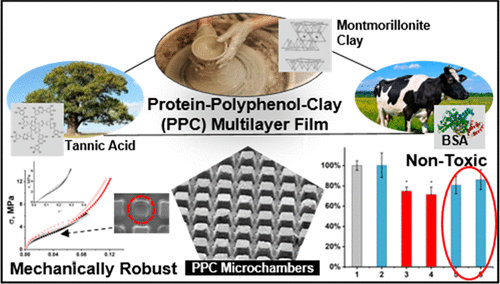当前位置:
X-MOL 学术
›
ACS Biomater. Sci. Eng.
›
论文详情
Our official English website, www.x-mol.net, welcomes your
feedback! (Note: you will need to create a separate account there.)
Arrays of Biocompatible and Mechanically Robust Microchambers Made of Protein–Polyphenol–Clay Multilayer Films
ACS Biomaterials Science & Engineering ( IF 5.4 ) Pub Date : 2020-09-15 , DOI: 10.1021/acsbiomaterials.0c00973 Maxim V. Kiryukhin 1 , Hooi Hong Lau 1 , Su Hui Lim 1 , Giorgiana Salgado 2 , Chen Fan 2 , Yi Zhen Ng 2 , David I. Leavesley 2 , Zee Upton 2
ACS Biomaterials Science & Engineering ( IF 5.4 ) Pub Date : 2020-09-15 , DOI: 10.1021/acsbiomaterials.0c00973 Maxim V. Kiryukhin 1 , Hooi Hong Lau 1 , Su Hui Lim 1 , Giorgiana Salgado 2 , Chen Fan 2 , Yi Zhen Ng 2 , David I. Leavesley 2 , Zee Upton 2
Affiliation

|
There is a growing demand for biocompatible and mechanically robust arrays of microcompartments loaded with minute amounts of active substances for sensing or controlled release applications. Here we report on a novel biocompatible composite material, protein–polyphenol–clay (PPC) multilayer film. The material is shown to be strong enough to make robust microchambers retaining the shape and dimensions of truncated square pyramids. We study the mechanical properties and biocompatibility of the PPC microchambers and compare them to those made of synthetic polyelectrolyte multilayer film, poly(styrenesulfonate)–poly(allylammonium) (PSS–PAH). The mechanical properties of the microchambers were characterized under uniaxial compression using nanoindentation with a flat-punch tip. The effective Young’s modulus of PPC microchambers, 166 ± 53 MPa, is found to be lower than that of PSS–PAH microchambers, 245 ± 52 MPa. However, the capacity to elastically absorb the energy of the former, 2.4 ± 1.0 MPa, is marginally higher than of the latter, 2.0 ± 1.3 MPa. Arrays of microchambers were sealed onto a polyethylene film, loaded with a model oil-soluble drug, and their biocompatibility was tested using an ex vivo 3D human skin reconstruct model. We found no evidence for toxicity with the PPC microchambers; however, PSS–PAH microchambers stimulated reduced cell density in the epidermis and significantly affected epidermal–dermal attachment. Both materials do not alter skin cell proliferation but affect skin cell differentiation. We interpret that rather than affecting epidermal barrier function, these data suggest the applied plastic films with microchamber arrays affect transpiration, normoxia, and moisture exchange.
中文翻译:

由蛋白质-多酚-粘土多层薄膜制成的生物相容性和机械坚固的微腔阵列
对于装载有微量活性物质以用于感测或控释应用的微隔室的生物相容性和机械坚固性阵列的需求不断增长。在这里,我们报道了一种新型的生物相容性复合材料,蛋白质-多酚-粘土(PPC)多层膜。所显示的材料足够坚固,可以制造出坚固的微腔,可以保留截短的方形金字塔的形状和尺寸。我们研究了PPC微腔室的机械性能和生物相容性,并将其与合成的聚电解质多层薄膜聚(苯乙烯磺酸盐)-聚(烯丙基铵)(PSS-PAH)制成。微腔室的机械性能在单轴压缩下使用带有压头的纳米压痕表征。PPC微腔室的有效杨氏模量为166±53 MPa,被发现低于245±52 MPa的PSS–PAH微腔室。但是,弹性吸收前者能量的能力为2.4±1.0 MPa,略高于后者的2.0±1.3 MPa。将微室阵列密封在聚乙烯膜上,并在其中装载模型油溶性药物,并使用离体3D人皮肤重建模型测试其生物相容性。我们没有发现PPC微腔有毒性的证据。然而,PSS-PAH微腔室刺激了表皮细胞密度的降低,并显着影响了表皮-真皮的附着。两种材料都不会改变皮肤细胞的增殖,但会影响皮肤细胞的分化。我们认为这些数据并未影响表皮屏障功能,而是表明所应用的带有微腔阵列的塑料薄膜会影响蒸腾作用,正常氧,
更新日期:2020-10-12
中文翻译:

由蛋白质-多酚-粘土多层薄膜制成的生物相容性和机械坚固的微腔阵列
对于装载有微量活性物质以用于感测或控释应用的微隔室的生物相容性和机械坚固性阵列的需求不断增长。在这里,我们报道了一种新型的生物相容性复合材料,蛋白质-多酚-粘土(PPC)多层膜。所显示的材料足够坚固,可以制造出坚固的微腔,可以保留截短的方形金字塔的形状和尺寸。我们研究了PPC微腔室的机械性能和生物相容性,并将其与合成的聚电解质多层薄膜聚(苯乙烯磺酸盐)-聚(烯丙基铵)(PSS-PAH)制成。微腔室的机械性能在单轴压缩下使用带有压头的纳米压痕表征。PPC微腔室的有效杨氏模量为166±53 MPa,被发现低于245±52 MPa的PSS–PAH微腔室。但是,弹性吸收前者能量的能力为2.4±1.0 MPa,略高于后者的2.0±1.3 MPa。将微室阵列密封在聚乙烯膜上,并在其中装载模型油溶性药物,并使用离体3D人皮肤重建模型测试其生物相容性。我们没有发现PPC微腔有毒性的证据。然而,PSS-PAH微腔室刺激了表皮细胞密度的降低,并显着影响了表皮-真皮的附着。两种材料都不会改变皮肤细胞的增殖,但会影响皮肤细胞的分化。我们认为这些数据并未影响表皮屏障功能,而是表明所应用的带有微腔阵列的塑料薄膜会影响蒸腾作用,正常氧,











































 京公网安备 11010802027423号
京公网安备 11010802027423号